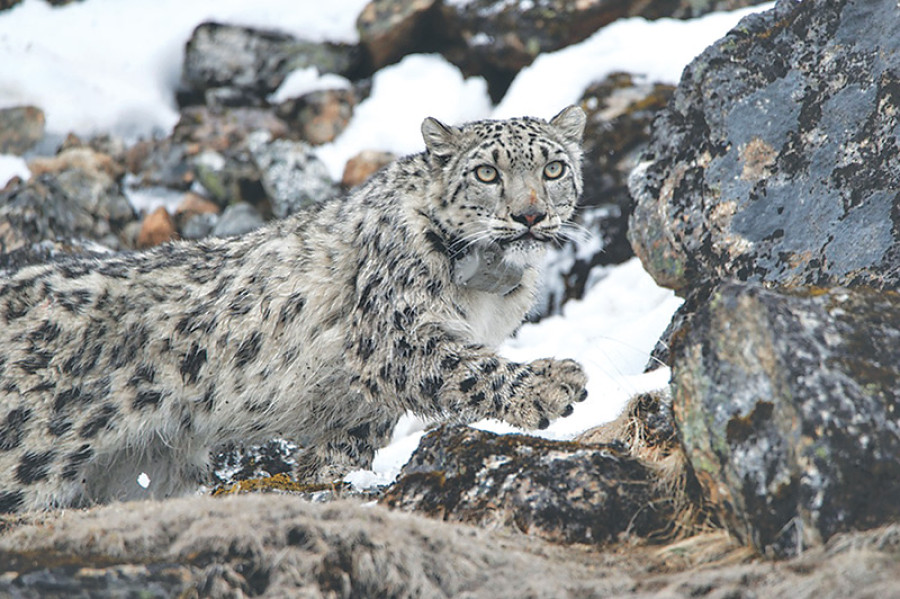Opinion
Saving the ghost
A big cat with chatoyant grey-green eyes, thick spotted fur and a long curling tail is a vulnerable species that inhabits the majestic mountain ecosystems of the Himalayas, Hindu Kush, Pamirs, the Tibetan Plateau, and the Mongolian steppes.
Tsewang Nuru Sherpa
A big cat with chatoyant grey-green eyes, thick spotted fur and a long curling tail is a vulnerable species that inhabits the majestic mountain ecosystems of the Himalayas, Hindu Kush, Pamirs, the Tibetan Plateau, and the Mongolian steppes. The snow leopard (Panthera uncia), a rarely sighted creature, represents the immaculate beauty of nature. With its innate ability to hide and thrive in the seemingly inhospitable terrain and craggy peaks of high mountains, the snow leopard has been listed as one of the world’s most elusive animals, garnering the title of “Mountain Ghost”. The idiosyncratic aptitude of the snow leopard to live in the harshest conditions in the remote mountains also epitomises the potential and the ability of the humans that reside in such areas. This cat blends in with the surroundings of the mountain people and lives with them in harmony. The majority of people in the mountains follow Buddhism: a religion that preaches that nature is the ultimate power, and that the existence of humanity is only possible when there is a peaceful consonance with nature. They see the snow leopard as an integral part of this nature that they so wholeheartedly worship. And it is this nature that has helped the mysterious cat survive and thrive in a most draconian domain.
Rarefied due to human actions
Despite the rise of global interest in these cats, poaching, the continuous pace of retaliatory killings due to snow leopards attacking livestock, and climate change have impaired their natural habitat, pushing them to the verge of extinction. Vanishing habitats and the reduction of the cat’s mammal prey have also contributed to the decline of the snow leopard. Data collated between 2008 and 2016 paints a worrisome picture, indicating 220 to 450 snow leopards are killed and traded annually. In Nepal, around six to 23 snow leopards fall victim to unabated poaching, as per Traffic, a wildlife trade monitoring network, in 2016. According to the WWF (World Wildlife Fund), the number of snow leopards has decreased by 20 percent worldwide. Despite this, in the context of Nepal, conservationists and government officials are optimistic about the increasing population of this endangered cat in the country, as numerous initiatives have been taken to protect the snow leopard. Therefore, the conservatory strides that are being taken to safeguard these magnificent species shouldn’t be overlooked.
Nepal at the top
Nepal, one of the 12 countries to host the snow leopard, has made historic strides by leading initiatives for snow leopard conservation. Nepal successfully launched its first-ever, climate-smart snow leopard landscape management plan during the International Snow Leopard Summit and Ecosystem Forum held in August, in Bishkek of Kyrgyzstan. This plan addresses the key elements of today’s emerging threats faced by the snow leopard, including the increasing risk of climate change. The model will be followed by the 11 other countries. In addition, Nepal has collared four snow leopards successfully in the last four years, which makes Nepal one of the few countries in the world to achieve this feat. These snow leopards are fitted with satellite-GPS collars and through satellite telemetry, the fitted snow leopards are monitored regularly. Furthermore, Man Bahadur Khadka, Director General of the Department of National Parks and Wildlife Conservation (DNPWC) added, “Nepal’s snow leopard conservation action plan is committed to ensuring 100 breeding snow leopards by 2020 and the collaring of snow leopards with satellite-GPS, a cutting-edge technology, will play a significant role in future snow leopard monitoring which is a key objective of this five-year plan.” The data collated from these snow leopards have aided conservationists in Nepal by identifying the movement pattern of snow leopards, their core habitat and preferences. According to the report published by the WWF, information attained from the previously collared snow leopards unveiled movements of the snow leopards between Nepal, India, and China, with one of them traversing up to 5,858m—the highest documented height so far for snow leopards. Mr Anil Manandhar, Country Representative of WWF Nepal has expressed his optimism, “The success of the collaring expedition opens up new frontiers in snow leopard conservation as well as new avenues to profile Nepal as a laboratory to help build on international collaboration in the conservation sector.” In addition, the involvement of local citizens and communities in snow leopard monitoring and conservation have helped in the establishment of local based awareness campaigns, livestock insurance schemes and improved the corral and herding system.
Nepal has been instrumental in bringing the plight of this elusive species into the spotlight. A core member in snow leopard conservation, Mr Ghana Shyam Gurung, Conservation Director, WWF Nepal said, “With the launch of the first ever snow leopard landscape management plan, Nepal has once again made conservation history by establishing itself as a leader in conservation, showing much-needed ambition despite facing some of the toughest environmental, economic and political conditions.” This clearly shows the commitment of Nepal in safeguarding this endangered species and its habitat. The community-based conservation program in Nepal promotes and encourages local villagers to be involved in the expedition team. Thus, today, locals are trained in setting up camera traps, collecting scat samples, and monitoring the snow leopard’s population, their habitat and local ecology. “This helps to create employment and develop essential skills,” Gurung explained, “and it allows locals to have a sense of ownership and makes the conservation process more reliable, transparent and accountable.”
This accomplishment should be applauded. It clearly exemplifies the commitment and diligence of conservationists in Nepal towards ameliorating snow leopard conservation efforts. The existence of the snow leopard has been identified as an indicator of a healthy ecosystem, therefore more research and study should be thoroughly conducted towards this end.
Sherpa is pursuing a Bachelor’s in Environmental Science from Nami College, Kathmandu




 8.12°C Kathmandu
8.12°C Kathmandu










